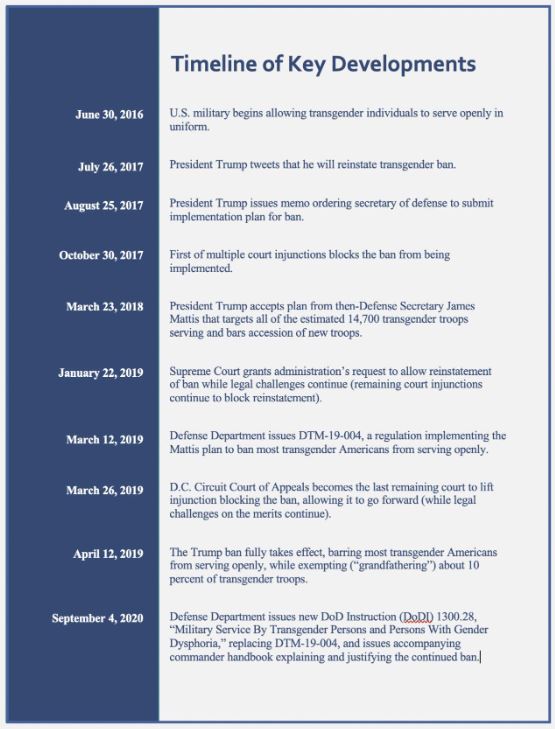Three Authors Served in Military Surgeon General Roles
WASHINGTON — President Donald Trump’s order banning transgender people from serving in the military has harmed the military’s reputation, weakened unit cohesion, promoted harassment and forced transgender personnel to choose between their well-being and their career, according to a new report.
On June 30, 2016, the military began allowing openly transgender individuals to serve in uniform. While DoD officials testified that the policy change was a success, Trump announced in July 2017 that he would reinstate the ban. After numerous delays, including several court challenges, the new policy went into effect in April 2019, banning transgender individuals from serving, with some exceptions grandfathering in already-enlisted individuals.
Trump cited the “tremendous medical costs” of gender transition-related treatment as a driving factor behind the ban. Defense and healthcare officials at the time pointed out that the cost was less than $8 million annually and a miniscule fraction of DoD’s medical budget, however. Trump also sought to justify the ban by arguing that allowing transgender people to serve openly promoted confusion among the ranks and led to the erosion of trust and morale among military units.
On the other hand, the study published by the Palm Center last month, with authors including three former military surgeons general, suggests the transgender ban has led to the very erosion that Trump described. President-elect Joe Biden has stated his intention to remove the ban once he is sworn into office next month.
The ban harms unit cohesion by promoting bigotry and harassment in the ranks, essentially giving permission to those with transphobic views to act on them, the report states. One Navy aviation electronics technician explained to the study’s authors that “having the ban as policy strongly signals a lack of support or care for transgender personnel.”
“Before the ban, the Navy’s stance was that transgender people are real people and they have a status and we’re going to help them transition to what they need to be so they can continue to serve,” according to the quote in the study. “Now that the ban has been reinstated, there’s no longer anyone trying to accept us anymore.”
By signaling to other servicemembers that transgender people have “second-class citizenship in the military,” it makes harassment more likely, reporting it more difficult, and undermines the overall readiness of the force, the report contends.
One positive effect noted by the report is that transgender servicemembers have reported cases of their cisgender colleagues reacting in a protective manner and expressing active opposition to the ban. The result in these cases has been more discussion about transgender issues and less casual dismissal of their needs.
The ban also thwarts access to medical care for transgender personnel by not only directly denying some types of care, but also by making open communication with physicians a career risk. Transgender servicemembers who have not been grandfathered in are forced to walk a tightrope when seeing a military physician by being open enough to receive appropriate care but not so open that they reveal something that might lead to a discharge.
An estimated 1,600 transgender troops were grandfathered in following the ban, but seeking medical care is not easy or straightforward for them either.
“Even grandfathered personnel have experienced slowdowns in medical care and artificial roadblocks to deployment, and must endure the requirement that they meet separate standards applied only to transgender personnel,” the report states.
The report includes testimony from several grandfathered servicemembers who sought transition-related care through military medical channels. They experienced considerable delays, poor care and confusion among military personnel as to what care was allowed under the ban.
“Much of the difficulty obtaining medical care, at least for those who were officially allowed to receive it, resulted from confusion and uncertainty among military and medical leaders about what the policy required, banned, or allowed,” the report states.
Consequently, servicemembers have been forced to become experts on the policy’s fine print, educating their physicians, superiors, and TRICARE staff about what care they are eligible for.
But even when transition-related care is granted, how to go about that care is a frequent source of confusion for servicemembers and their physicians alike. One grandfathered sailor told the study’s authors that there was little consistency between military treatment facilities or even the same facility over time and that her medical team had “no agreed-upon, official process for setting up her treatment plan.”
“Our inquiry found that the ban has created a climate of confusion and uncertainty among both transgender servicemembers and the leaders who are charged with caring for them,” the report states.
The Palm Center lists the following downsides to the ban:
- Artificially constricts the military recruiting pool by disqualifying or discouraging an estimated 205,850 transgender Americans of prime recruiting age.
- Harms the military’s reputation by casting the armed forces as intolerant.
- Weakens retention by placing unnecessary burdens on serving personnel.
- Undermines unit cohesion by enabling harassment and breaking bonds of trust.
- Harms troop morale by stigmatizing transgender members.
- Denies military members necessary medical care.
- Undermines leadership by creating separate and confusing standards and rules.
Among the authors were Navy Vice Adm. Donald C. Arthur, (Ret.) former Navy surgeon general; Army Maj. Gen. Gale Pollock, (Ret.) former acting Army surgeon general; and Rear Adm. Alan M. Steinman, USPHS/USCG (Ret.) former U.S. Coast Guard director of health and safety (surgeon general equivalent).



